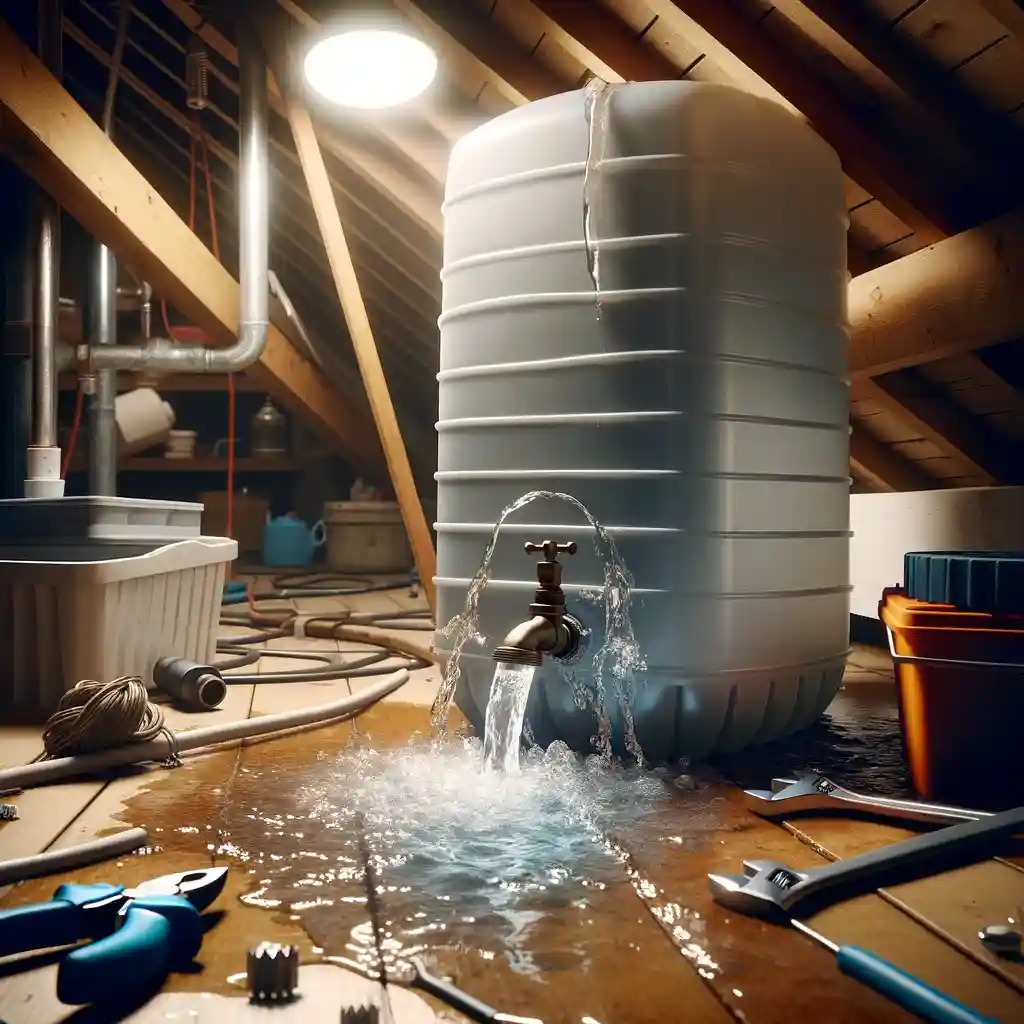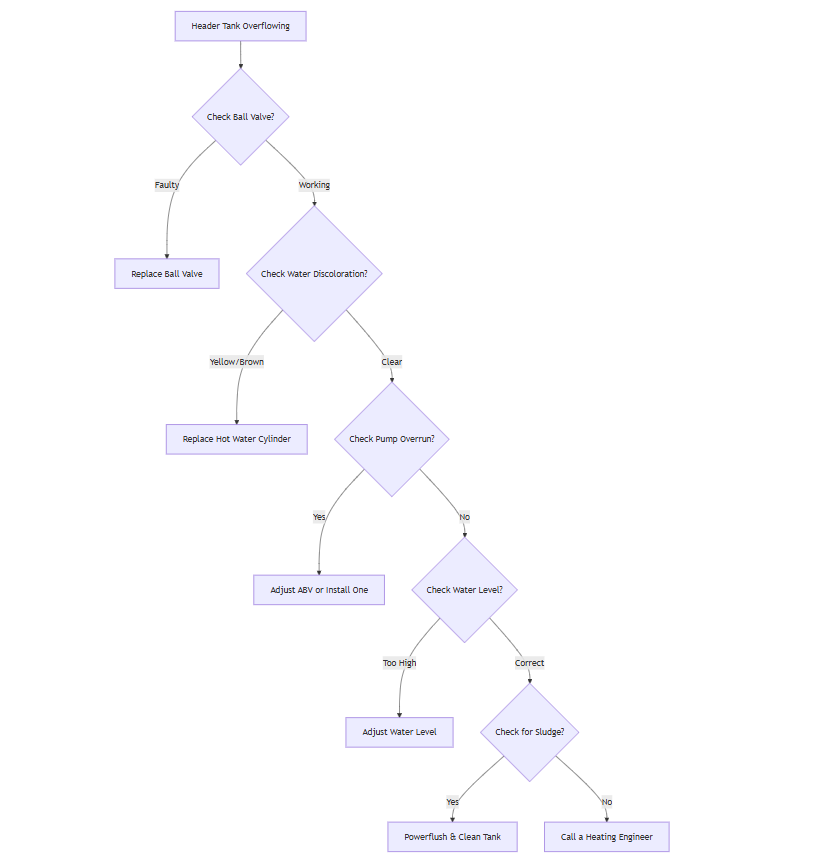What causes a header tank to overflow

- What causes a header tank to overflow
An overflowing header tank is a common but potentially damaging issue in open vented central heating systems. Whether caused by faulty components, system imbalances, or poor maintenance, an unchecked overflow can lead to water damage, energy inefficiency, and costly repairs.
This guide will help you:
✔ Understand the function and role of a header tank in your heating system.
✔ Identify common causes of overflow and how to troubleshoot them.
✔ Learn practical fixes and preventative maintenance tips, including smart technology solutions.
✔ Ensure compliance with UK plumbing regulations to keep your heating system safe and efficient.
What Is a Header Tank and Why Does It Overflow?
A header tank, also known as a feed and expansion (F&E) cistern, is an essential part of an open vented heating system. Typically installed in the loft, it maintains the water level in the heating system while compensating for thermal expansion when water heats up.
🔹 Key Components of a Header Tank
| Component | Function |
|---|---|
| Ball Valve | Controls water inflow, opening and closing based on water level. |
| Cold Feed Pipe | Supplies water to the heating system. |
| Open Vent Pipe | Releases excess pressure and prevents overheating. |
| Overflow Pipe | Directs excess water outside to prevent flooding. |
When these components malfunction or the system is poorly maintained, the header tank can overflow, leading to water waste, potential leaks, and even boiler malfunctions.
Common Causes of a Header Tank Overflowing
Here are the most frequent reasons why a header tank might overflow, along with troubleshooting steps:
Faulty Ball Valve
- If the ball valve is stuck open or worn out, it continuously allows water into the tank.
✅ Solution: Replace or repair the ball valve.
Hot Water Cylinder Coil Leak
- A perforation in the coil inside your hot water cylinder allows central heating water to mix with domestic hot water, increasing water volume and causing overflow.
✅ Solution: Check for discolored water (brown/yellow) from taps—this indicates contamination. If found, replace the cylinder.
Boiler Pump Overrun Issues
- If the boiler pump continues running after the system is off, excess heat is pushed into the system, leading to overflow.
✅ Solution: Adjust or install an Automatic Bypass Valve (ABV) to regulate pressure.
Incorrect Cold Water Level Settings
- If the water level is set too high, small expansions can cause spills.
✅ Solution: Set proper water levels:- Header Tanks (non-potable water): 80mm
- F&E Tanks (potable water): 200mm
Blockages from Sludge Build-up
- Over time, sludge accumulates in open vented heating systems, restricting water flow and causing overheating or overflow.
✅ Solution: Perform a power flush or manually remove sludge from the tank.
Freezing in Winter
- A frozen tank blocks expansion and may cause burst pipes.
✅ Solution: Install an insulation jacket or use tank heaters to prevent freezing.
How to Fix an Overflowing Header Tank: A Step-by-Step Guide
🚀 Follow this flowchart to diagnose and fix your header tank issue:

This decision tree ensures you troubleshoot the issue efficiently.
Preventative Measures: Smart Solutions & Maintenance
💡 Avoid costly repairs by upgrading your system with modern solutions:
Smart Leak & Overflow Sensors
- Install Wi-Fi-enabled water leak sensors in the loft.
- Receive real-time alerts on your phone if an overflow is detected.
Consider a Sealed Heating System
- Convert to a sealed system (no header tank) to eliminate overflow risks.
- Benefits: Better efficiency, lower maintenance, and no risk of contamination.
Schedule Annual Maintenance
- Bleed radiators to remove trapped air that can cause pressure imbalances.
- Inspect pipes for sludge buildup to prevent overheating.
- Check ball valves and vent pipes regularly.
UK Plumbing Regulations & Compliance
When working on header tanks, ensure compliance with UK plumbing regulations to maintain safety and efficiency.
| Regulation | Requirement |
|---|---|
| Water Fittings Regulations 1999 | Prevents waste, misuse, and contamination of water. |
| Water Byelaw 30 | Requires screened overflow pipes and proper ventilation. |
| BS 4213:2004 | Governs materials and safety standards for water cisterns. |
📌 Tip: If upgrading your system, consult a Gas Safe engineer to ensure compliance.
Conclusion: When to Call a Professional
While basic troubleshooting can solve many issues, certain cases require professional intervention:
🚨 Signs You Need a Plumber:
✔ Continuous overflow despite adjustments.
✔ Discolored water from taps.
✔ Noisy pipes or irregular heating performance.
Ignoring an overflowing header tank can lead to water damage, heating inefficiency, and high repair costs. Take proactive steps with regular maintenance, smart monitoring, and compliance checks.
💡 Need expert help? Contact a qualified heating engineer for diagnosis and repair.
Would you like assistance in creating a compliance diagram or regulatory comparison table to make this article even more engaging? 🚀
